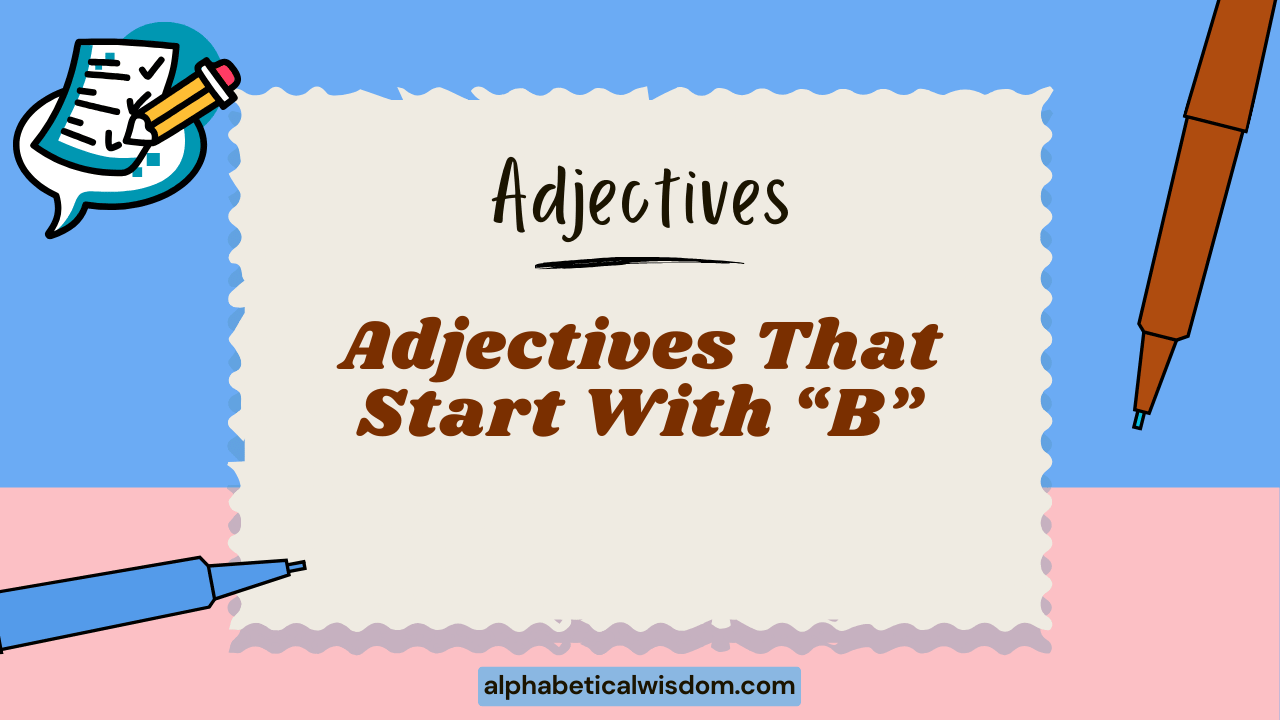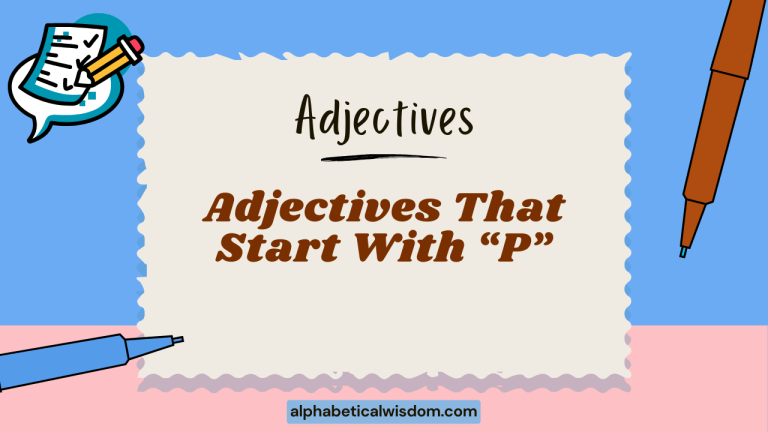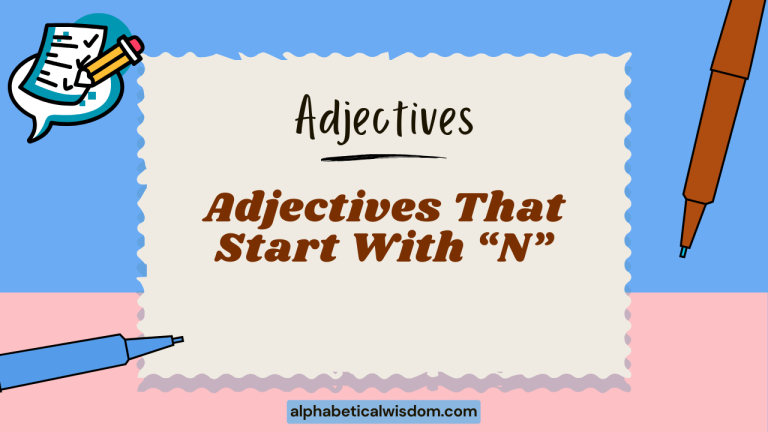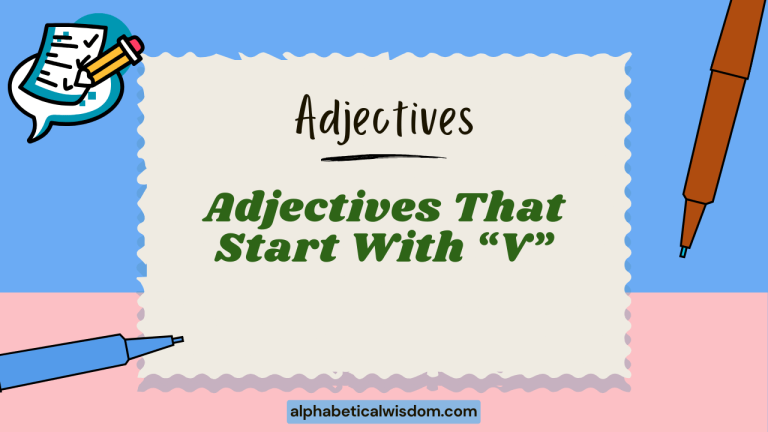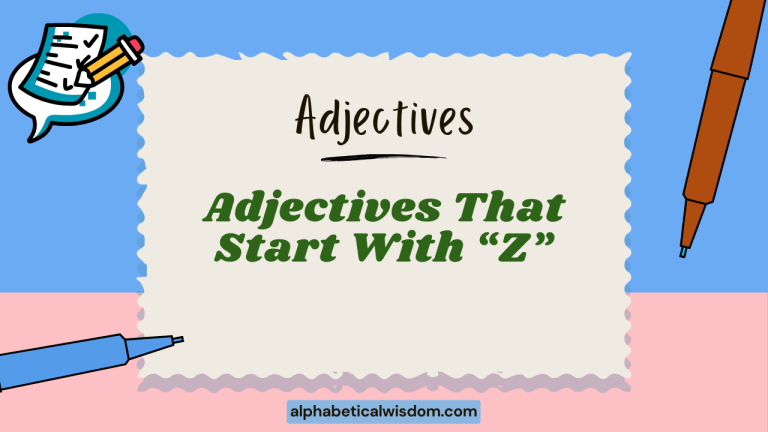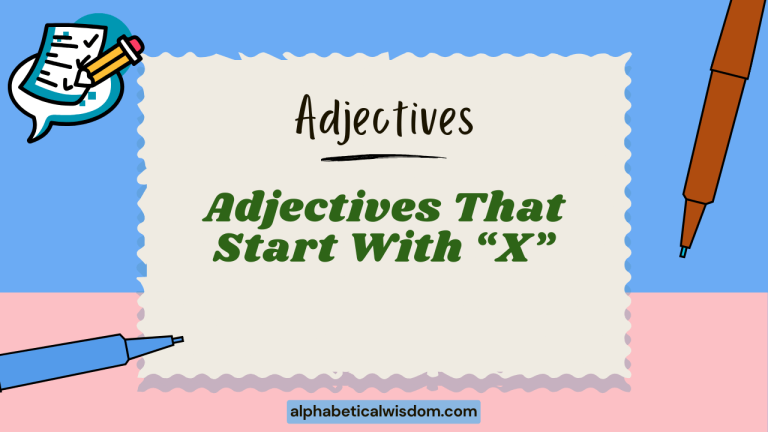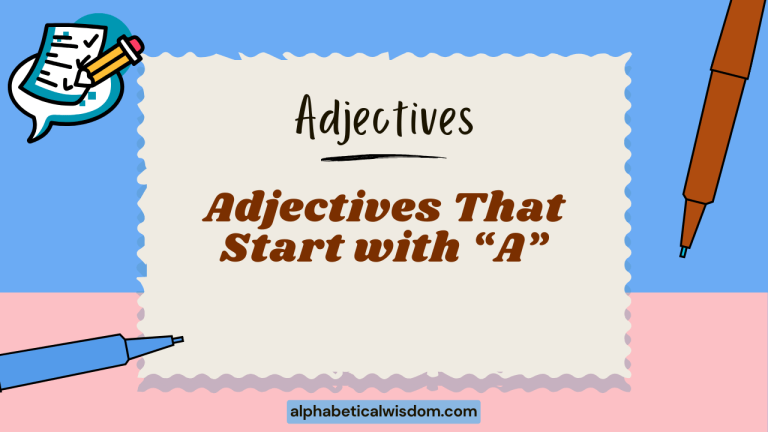Adjectives That Start With B: A Comprehensive Guide
Adjectives are essential for adding detail and color to our language, making descriptions more vivid and precise. Focusing on adjectives that start with the letter “B” can significantly enhance your vocabulary and improve your descriptive writing and speaking skills.
This article provides a comprehensive exploration of “B” adjectives, covering their definitions, usage, and examples. Whether you’re a student, a writer, or simply someone looking to expand your linguistic toolkit, this guide will equip you with the knowledge and practice you need to master these descriptive words.
Understanding and using a wide range of adjectives is crucial for effective communication. We will explore common and less common adjectives starting with “B”, providing clear examples and practical exercises to solidify your understanding.
By the end of this guide, you’ll be able to confidently incorporate these adjectives into your everyday language.
Table of Contents
- Definition of Adjectives
- Structural Breakdown of Adjectives
- Types and Categories of “B” Adjectives
- Examples of “B” Adjectives
- Usage Rules for “B” Adjectives
- Common Mistakes with “B” Adjectives
- Practice Exercises
- Advanced Topics
- Frequently Asked Questions
- Conclusion
Definition of Adjectives
An adjective is a word that modifies a noun or pronoun, providing more information about it. Adjectives describe the qualities, characteristics, or states of being of the nouns they modify.
They answer questions like “What kind?”, “Which one?”, “How many?”, or “How much?”. Understanding adjectives is fundamental to constructing detailed and expressive sentences.
Adjectives can be classified based on their function. Descriptive adjectives provide details about appearance, color, size, or other qualities. Quantitative adjectives specify quantity or number. Demonstrative adjectives point out specific nouns. Possessive adjectives indicate ownership. This classification helps in understanding how different types of adjectives contribute to sentence structure and meaning.
In different contexts, adjectives can significantly alter the meaning of a sentence. For example, “a big house” conveys a different image than “a small house.” The choice of adjective is crucial in conveying the intended message and creating a specific impression. Adjectives are essential tools for writers and speakers to paint vivid pictures with words.
Structural Breakdown of Adjectives
Adjectives typically precede the noun they modify, as in “a beautiful flower.” However, they can also follow a linking verb, such as is, are, was, or were, where they act as a subject complement, as in “The flower is beautiful.” Understanding these structural positions is vital for correct sentence construction.
Adjectives can also be modified by adverbs, which add further detail. For instance, in the phrase “extremely beautiful,” the adverb “extremely” intensifies the adjective “beautiful.” This combination allows for even more precise and nuanced descriptions.
Many adjectives can form comparative and superlative degrees to show differences in quality. Comparative adjectives compare two things (e.g., “bigger”), while superlative adjectives compare three or more things (e.g., “biggest”).
These forms are essential for expressing relative degrees of characteristics.
Types and Categories of “B” Adjectives
Descriptive Adjectives
Descriptive adjectives provide details about a noun’s qualities or characteristics. They can describe appearance, personality, or any other attribute that helps create a clearer picture of the noun.
Positive Adjectives
Positive adjectives describe favorable or desirable qualities. They are used to express approval, admiration, or appreciation.
Negative Adjectives
Negative adjectives describe unfavorable or undesirable qualities. They are used to express disapproval, criticism, or concern.
Adjectives of Size
Adjectives of size indicate the physical dimensions of a noun, such as its length, width, or height. These adjectives are essential for providing a sense of scale.
Adjectives of Color
Adjectives of color specify the hue or shade of a noun. They add visual detail and can evoke specific emotions or associations.
Examples of “B” Adjectives
Descriptive Adjectives Examples
The following table provides examples of descriptive adjectives that start with the letter “B,” along with example sentences to illustrate their usage.
| Adjective | Example Sentence |
|---|---|
| Bald | The old man had a bald head. |
| Barren | The landscape was barren and desolate. |
| Bashful | The little girl was bashful and hid behind her mother. |
| Bawdy | The play was known for its bawdy humor. |
| Beaming | She had a beaming smile on her face. |
| Beautiful | The sunset was beautiful and breathtaking. |
| Beefy | The bouncer was a beefy man with a stern look. |
| Believable | His story was believable and convincing. |
| Belligerent | The drunk man became belligerent and started a fight. |
| Beneficial | Exercise is beneficial for your health. |
| Benevolent | The benevolent king was loved by his people. |
| Bent | The old tree had a bent trunk. |
| Berserk | The crowd went berserk after the team won. |
| Best | This is the best cake I’ve ever tasted. |
| Better | I feel better after taking the medicine. |
| Bewildered | He looked bewildered by the complicated instructions. |
| Big | They live in a big house. |
| Billowing | The billowing clouds filled the sky. |
| Bitter | The coffee had a bitter taste. |
| Bizarre | The artist created a bizarre sculpture. |
| Black | She wore a black dress to the party. |
| Bleak | The future looked bleak after the company closed. |
| Blessed | They felt blessed to have such a loving family. |
| Blind | The blind man used a cane to navigate. |
| Blissful | They spent a blissful day at the beach. |
| Bloody | The bloody battle ended with many casualties. |
Positive Adjectives Examples
The following table presents positive adjectives starting with “B,” along with example sentences to demonstrate their usage in a positive context.
| Adjective | Example Sentence |
|---|---|
| Balanced | A balanced diet is essential for good health. |
| Beautiful | She has a beautiful singing voice. |
| Beloved | He was a beloved leader in the community. |
| Beneficial | The new policy was beneficial to everyone. |
| Benevolent | The benevolent organization helped many families. |
| Best | This is the best opportunity for her career. |
| Better | The new plan is better than the old one. |
| Blissful | They had a blissful honeymoon. |
| Bold | She made a bold decision to start her own business. |
| Brave | The brave firefighter rescued the children from the burning building. |
| Bright | She has a bright future ahead of her. |
| Brilliant | He is a brilliant scientist. |
| Brisk | They took a brisk walk in the morning. |
| Brotherly | He showed brotherly love to his friends. |
| Buoyant | Her buoyant personality lifted everyone’s spirits. |
| Bustling | The city was bustling with activity. |
| Beautifying | The new park is beautifying the neighborhood. |
| Blooming | The garden was blooming with colorful flowers. |
| Boundless | He has boundless energy and enthusiasm. |
| Brainy | She is a brainy student with excellent grades. |
| Breathless | The view from the top of the mountain was breathless. |
| Breathtaking | The scenery was absolutely breathtaking. |
| Balmy | The weather was balmy and pleasant. |
| Big-hearted | He is a big-hearted person who always helps others. |
Negative Adjectives Examples
This table provides examples of negative adjectives starting with “B,” along with example sentences to show their usage in a negative context.
| Adjective | Example Sentence |
|---|---|
| Bad | He had a bad experience at the restaurant. |
| Barren | The land was barren and unproductive. |
| Belligerent | His belligerent attitude caused many problems. |
| Bent | The metal was bent and unusable. |
| Bitter | She felt bitter after the betrayal. |
| Bleak | The forecast for the economy was bleak. |
| Blind | He was blind to the consequences of his actions. |
| Bloody | The bloody crime scene was disturbing. |
| Blunt | His blunt remarks offended many people. |
| Boastful | His boastful attitude was annoying. |
| Boring | The movie was long and boring. |
| Bossy | She had a bossy personality. |
| Bottomless | The problems seemed bottomless. |
| Brash | His brash behavior was inappropriate. |
| Brittle | The old bones were brittle and easily broken. |
| Broken | The toy was broken and unusable. |
| Brutal | The dictator ruled with a brutal hand. |
| Bankrupt | The company went bankrupt after the scandal. |
| Bothersome | The flies were bothersome during the picnic. |
| Backward | The country’s policies were backward and outdated. |
Adjectives of Size Examples
The table below provides examples of adjectives of size that begin with the letter “B,” along with example sentences to illustrate their usage.
| Adjective | Example Sentence |
|---|---|
| Big | They live in a big house. |
| Broad | The river was broad and deep. |
| Bulky | The package was bulky and difficult to carry. |
| Burly | The burly man lifted the heavy box with ease. |
| Babyish | He has a babyish face. |
| Behemoth | The behemoth truck took up two lanes on the road. |
Adjectives of Color Examples
The following table provides examples of adjectives of color starting with the letter “B,” along with example sentences to demonstrate their usage.
| Adjective | Example Sentence |
|---|---|
| Black | She wore a black dress to the party. |
| Blue | The sky was a clear blue. |
| Brown | The dog had brown fur. |
| Bronze | The statue was made of bronze. |
| Burgundy | She wore a burgundy sweater. |
| Beige | The walls were painted a beige color. |
| Blond | The girl had blond hair. |
Usage Rules for “B” Adjectives
Adjectives typically precede the noun they modify. For example, “a big tree” is correct, while “a tree big” is incorrect. However, when an adjective follows a linking verb, it acts as a subject complement, as in “The tree is big.”
Some adjectives are non-gradable, meaning they cannot be used in comparative or superlative forms. For example, “unique” is non-gradable because something is either unique or it is not; it cannot be “more unique” or “most unique.” When using adjectives that start with “B”, it is important to consider if they are gradable.
When using multiple adjectives to describe a noun, follow a general order: quantity, opinion, size, age, shape, color, origin, material, and purpose. For example, “a few beautiful large old round brown German wooden tables.” While this is a general guideline, the specific order can sometimes vary based on context and emphasis.
Common Mistakes with “B” Adjectives
One common mistake is using adjectives as adverbs. For example, saying “He ran bad” instead of “He ran badly.” Remember that adjectives modify nouns, while adverbs modify verbs, adjectives, or other adverbs.
Another frequent error is misusing comparative and superlative forms. For example, saying “more better” instead of “better,” or “most best” instead of “best.” Use the correct comparative and superlative forms of the adjectives.
A further mistake involves incorrect adjective order when using multiple adjectives. For example, saying “a brown old dog” instead of “an old brown dog.” Follow the general order of adjectives to ensure clarity and grammatical correctness.
Here are some examples of common mistakes and their corrections:
| Incorrect | Correct | Explanation |
|---|---|---|
| He felt badly. | He felt bad. | “Bad” is an adjective describing his state of being, not an adverb describing how he felt. |
| This is more better. | This is better. | “Better” is already the comparative form of “good,” so “more better” is redundant. |
| A black old cat. | An old black cat. | The correct order is age before color. |
Practice Exercises
Exercise 1: Fill in the Blanks
Fill in the blanks with an appropriate adjective that starts with the letter “B.”
| Question | Answer |
|---|---|
| 1. The _________ dog barked loudly at the mailman. | Big |
| 2. She wore a _________ dress to the formal event. | Beautiful |
| 3. The _________ landscape stretched as far as the eye could see. | Barren |
| 4. He made a _________ decision to quit his job and travel the world. | Bold |
| 5. The _________ child hid behind his mother, too shy to speak. | Bashful |
| 6. A _________ breeze swept through the trees. | Balmy |
| 7. The _________ building towered over the city skyline. | Behemoth |
| 8. He made a _________ comment that was uncalled for. | Brutal |
| 9. She offered a _________ smile to her friend. | Beaming |
| 10. The _________ economy was struggling to recover. | Bleak |
Exercise 2: Sentence Completion
Complete the following sentences using adjectives that start with “B” to make them more descriptive.
| Question | Answer |
|---|---|
| 1. The _________ flowers filled the garden with color. | Blooming |
| 2. He was known for his _________ sense of humor. | Bawdy |
| 3. The _________ child was always getting into trouble. | Brash |
| 4. The _________ sea stretched out before them. | Blue |
| 5. The _________ old house stood on the hill. | Bent |
| 6. The _________ forest was dark and mysterious. | Black |
| 7. The _________ sky was filled with stars. | Black |
| 8. The _________ new employee was full of energy. | Brisk |
| 9. The _________ leader inspired his followers. | Brave |
| 10. The _________ landscape was devoid of life. | Barren |
Exercise 3: Error Correction
Identify and correct the errors in the following sentences related to the use of “B” adjectives.
| Question | Answer | Correction |
|---|---|---|
| 1. She is a more beautiful girl than her sister. | She is a more beautiful girl than her sister. | She is a *more beautiful* girl than her sister. (Correct) |
| 2. He felt badly after the accident. | He felt badly after the accident. | He felt *bad* after the accident. |
| 3. That was a boring long movie. | That was a boring long movie. | That was a *long boring* movie. |
| 4. It was a bitter cold day. | It was a bitter cold day. | It was a *bitterly cold* day. |
| 5. This is the most best cake ever. | This is the most best cake ever. | This is the *best* cake ever. |
| 6. She wore a black leather old jacket. | She wore a black leather old jacket. | She wore an *old black leather* jacket. |
| 7. The building was big tall. | The building was big tall. | The building was *big and tall*. |
| 8. He is a brainy intelligent student. | He is a brainy intelligent student. | He is a *brainy* student. |
| 9. The situation looked bleakly. | The situation looked bleakly. | The situation looked *bleak*. |
| 10. The child was very bashful. | The child was very bashful. | The child was *very bashful*. (Correct) |
Advanced Topics
Hyphenated Adjectives: Many adjectives starting with “B” can be hyphenated when used as compound modifiers before a noun. For example, “best-selling author” or “broad-minded approach.” This usage combines two or more words to act as a single adjective, adding precision and clarity to the description. Hyphenation helps avoid ambiguity and ensures that the words are understood as a single unit modifying the noun. For instance, “a well-known actor” is clearer than “a well known actor,” where “well” could mistakenly be interpreted as modifying “known” separately.
Adjective Phrases: Adjectives can be part of larger phrases that provide more detailed descriptions. For example, “blessed with good fortune” or “burdened by responsibilities.” These phrases add depth and complexity to the description, offering a more nuanced understanding of the noun being modified. The use of prepositions and other words alongside the adjective enriches the descriptive power of the language.
Subjective vs. Objective Adjectives: Some adjectives starting with “B” can be subjective, reflecting personal opinions or feelings (e.g., “beautiful”), while others are more objective, based on measurable facts (e.g., “big”). Recognizing this distinction is important for effective communication, as subjective adjectives can vary based on individual perspectives, while objective adjectives aim for a more universal understanding.
Frequently Asked Questions
Q1: What is the difference between an adjective and an adverb?
A: An adjective modifies a noun or pronoun, describing its qualities or characteristics. An adverb, on the other hand, modifies a verb, adjective, or another adverb, providing information about how, when, where, or to what extent something is done. For example, “a beautiful flower” (adjective) versus “she sings beautifully” (adverb).
Q2: Can an adjective modify another adjective?
A: No, adjectives cannot directly modify other adjectives. Instead, adverbs are used to modify adjectives. For example, “an extremely beautiful flower,” where “extremely” (an adverb) modifies “beautiful” (an adjective).
Q3: What is a comparative adjective?
A: A comparative adjective is used to compare two nouns. It usually ends in “-er” or is preceded by “more.” For example, “bigger” or “more beautiful.” Comparative adjectives indicate which of the two nouns has a greater degree of the quality being described.
Q4: What is a superlative adjective?
A: A superlative adjective is used to compare three or more nouns, indicating which has the greatest degree of the quality being described. It usually ends in “-est” or is preceded by “most.” For example, “biggest” or “most beautiful.”
Q5: How do I know the correct order of adjectives when using multiple adjectives?
A: The general order of adjectives is: quantity, opinion, size, age, shape, color, origin, material, and purpose. For example, “a few beautiful large old round brown German wooden tables.” This order helps ensure clarity and grammatical correctness, but can sometimes vary based on context and emphasis.
Q6: What are non-gradable adjectives?
A: Non-gradable adjectives are those that cannot be used in comparative or superlative forms because they represent absolute qualities. For example, “unique” is non-gradable because something is either unique or it is not; it cannot be “more unique” or “most unique.”
Q7: Can adjectives be used as nouns?
A: In some cases, adjectives can be used as nouns, especially when referring to a group of people with a particular characteristic. For example, “the poor” refers to poor people in general. This usage is often seen with adjectives describing social or economic status.
Q8: What is the difference between a descriptive and a possessive adjective?
A: A descriptive adjective describes the qualities or characteristics of a noun, while a possessive adjective indicates ownership. For example, “a beautiful flower” (descriptive) versus “my flower” (possessive).
Q9: How do I use adjectives correctly in sentences with linking verbs?
A: When an adjective follows a linking verb (such as is, are, was, were), it acts as a subject complement, describing the subject of the sentence. For example, “The flower is beautiful.” The adjective “beautiful” describes the subject “flower.”
Q10: What are some common mistakes to avoid when using adjectives?
A: Common mistakes include using adjectives as adverbs (e.g., “He ran bad” instead of “He ran badly“), misusing comparative and superlative forms (e.g., “more better” instead of “better”), and incorrect adjective order (e.g., “a brown old dog” instead of “an old brown dog”).
Conclusion
Mastering adjectives that start with the letter “B” can significantly enhance your ability to describe and communicate effectively. From descriptive adjectives like “beautiful” and “barren” to positive adjectives like “brave” and “beneficial,” each word adds a unique nuance to your language.
Understanding their usage rules, avoiding common mistakes, and practicing with exercises will solidify your knowledge and confidence. Remember, adjectives are essential tools for creating vivid and engaging descriptions.
Continue to expand your vocabulary and practice using these adjectives in various contexts. Pay attention to how native speakers use them in everyday conversation and writing.
By consistently applying what you’ve learned, you’ll not only improve your English grammar but also enrich your overall communication skills. Keep exploring, keep practicing, and enjoy the journey of mastering the English language.
